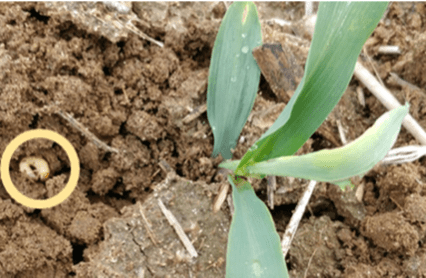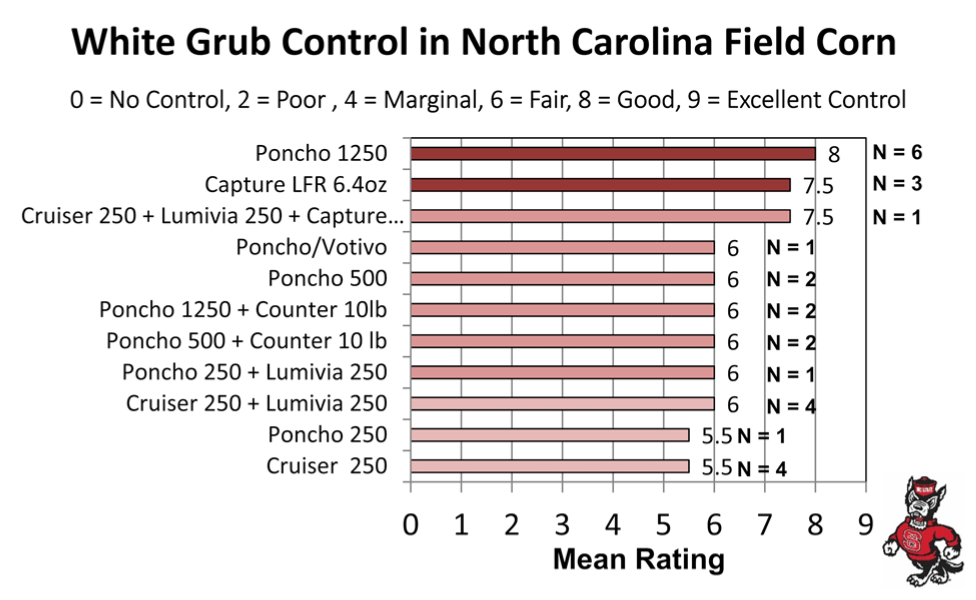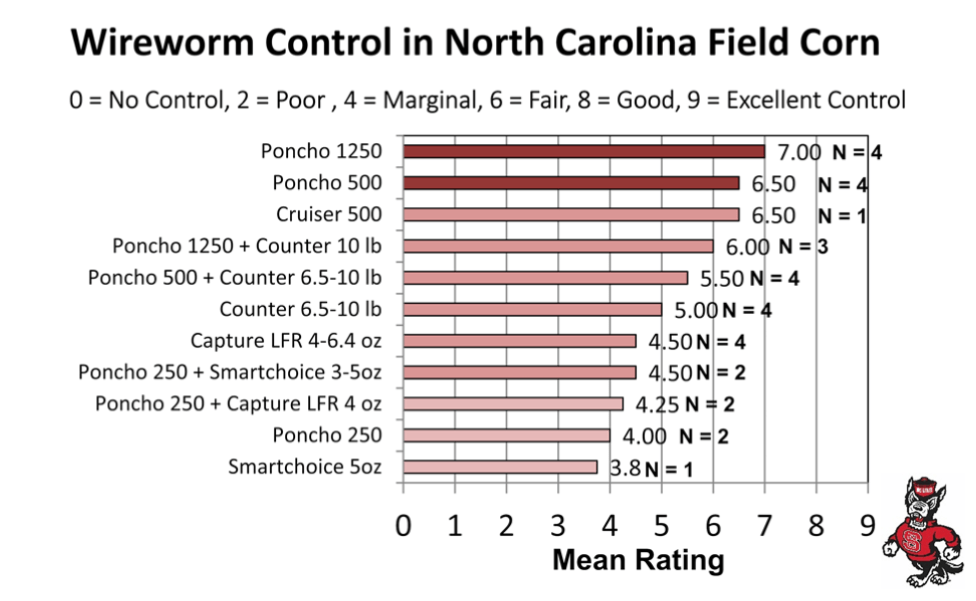Edwin Afful, Nurani Illahi and Kelly Hamby
University of Maryland, Department of Entomology

Spending most of their lives in the soil, they feed on our cherished seeds, and cause stand reductions that affect yield. Who are these critters and what can we do to save our seeds? White grubs and wireworms are a part of soil insect pest complex known to be culprits in the “covert stand reduction operation” in small grain and corn fields. Seed corn maggots, slugs, and cutworms can also cause early season stand reduction, and their damage can be distinguished from grubs and wireworms. The early developmental stages of grubs and wireworms occur on our blindside—in the soil. Larva of both species are the perpetrators of the illegal acts against our seeds, and there are no effective rescue treatments once damage is visible. Economic populations of these pests vary by season, depend upon a variety of factors, and are sporadic. In our recent studies we have not seen economic damage; however, control decisions should be based on pest history at your site and sampling information.
Identification

White grubs are the immature stages of scarab beetles, and multiple species (1-3 year life cycle depending on species) occur and feed upon plant roots as they develop. They have a characteristic “C” shape (Fig. 1, circled), have 3 pairs of legs immediately behind their head, and the entire grub body measures 0.25-1 inch in length. They can be identified to species based on the pattern of the hairs on the underside of their end (“raster”, Fig. 2 arrow). For further information on identification and life cycles, see resources from Ohio State6 and Purdue4.
Wireworms are the immature stages of click beetles, and multiple species with different life histories occur in most grain growing regions. Wireworms chew into seeds and stems, leaving holes, dead spots, or hollowed out seeds on seedlings. They are 0.25-0.75 inches long and have slender semi-cylindrical or cylindrical bodies that can be a white, yellowish, or coppery color with three small pairs of legs behind the head. On their end, they have a flattened segment with a “keyhole-shaped” notch that can look similar to the chewing mouthparts on the head (Fig. 3).

Damage
Grubs and wireworms both cause stand reduction; however, there are some distinguishable differences. Damage by wireworms and grubs are usually confined to certain areas of a field where populations are high or where soil conditions were optimum for egg laying and larval development.
White grubs feed on roots, chewing off the fine hairs on the roots. This reduces root uptake of water and phosphorus, resulting in aboveground symptoms of wilting and purpling of the stem. Severely infested fields often suffer stand loss when injured plants die.
Wireworms typically feed on the germ of corn kernels or hollow out the kernel, killing the plant. Wireworms may also cut off small roots or tunnel into the underground portions of the root or stem of young corn plants. If feeding is above the growing point, holes will appear in the leaves above ground.
Sampling
Sampling must occur before tilling and planting and should be done once it warms up enough for grubs and wireworms to be active at the soil surface (soil temperature at 6 inch depth >45 °F)3, 7. One to two samples should be taken per 10 acres with no less than 5 locations per field. To sample, dig out a 1-foot square 6 inches deep and dump the soil in a tray or sift it with ¼” hardware cloth to look for grubs and wireworms. While economic thresholds have not been established, an average of 1 white grub and/or wireworm per square foot would warrant an at-planting or seed treatment insecticide3, 7.
Management
Cultural management: Rotation is the most effective, and often the lowest cost, cultural tactic for reducing many grub and wireworm problems. Both grubs and wireworms prefer grass hosts, and rotation of corn and small grains with a non-grass crop reduces populations; however, weeds must be controlled to ensure there are no host plants. Planting under warm conditions allows seeds to germinate rapidly and plants may outgrow wireworms. Certain species of wireworms are abundant only in poorly drained soils; therefore, proper drainage of soils can reduce the wireworm threat. The use of starter fertilizer, timely planting, and effective weed management will also help reduce white grub and wireworm damage2.
Biological control: Organisms such as birds, parasitic nematodes, and fungal pathogens prey on white grubs and wireworms. The effectiveness of two beneficial nematodes were studied on turfgrass against grubs in California with some success1. Further research is required to effectively use biological control for these pests.

Chemical Control: There are no effective rescue treatments once white grub and wireworm damage is visible. However, commercial seed treatments and at-planting insecticides have varying effectiveness for grub and wireworm protection prior to damage. Dr. Dominic Reisig at North Carolina State University has been performing efficacy trials in field corn with grub and wireworm pressure, and has rated a variety of products against each based on his results. The N values indicate the number of trials each product was used in, and the values are a rating from 0 (no control) to 9 (excellent control), with the best performance products in dark red. Most products and rates provide fair control of grubs5, with heavy grub pressure requiring a higher seed treatment rate or in-furrow applications of Capture® (pyrethroid insecticide; Fig. 4). Wireworms require at least a 500 rate of seed treatment for fair control, with slightly better control at the 1250 rate (Fig. 5).

Further Reading/ References
Koppenhöfer,A.M., Wilson,M., Brown, I., Kaya, H.K., and R. Gaugler, Biological Control Agents for White Grubs (Coleoptera: Scarabaeidae) in Anticipation of the Establishment of the Japanese Beetle in California, Journal of Economic Entomology, Volume 93, Issue 1, 1 February 2000, Pages 71–80, https://doi.org/10.1603/0022-0493-93.1.71
NC State extension: Managing Insect Pests in Organically Certified Corn: https://entomology.ces.ncsu.edu/managing-pests-in-organically-certified-corn/
Owens, D., and B. Cissel. Insect Management in Field Corn – 2018: https://cdn.extension.udel.edu/wp-content/uploads/2018/05/02095804/Insect-Management-In-Field-Corn-20181.pdf
Purdue University Field Crops IPM. White Grubs: https://extension.entm.purdue.edu/fieldcropsipm/insects/corn-whitegrubs.php
Reisig, D., and E. Goldsworthy. Efficacy of Insecticidal Seed Treatments and Bifenthrin In-Furrow for Annual White Grub, Arthropod Management Tests, Volume 43, Issue 1, 2018, tsx135-136
https://academic.oup.com/amt/article/43/1/tsx135/4781660
https://academic.oup.com/amt/article/43/1/tsx136/4781661
https://academic.oup.com/amt/article/43/1/tsx137/4781662
Shetlar, D.J., and J. Andon. Identification of White Grubs in Turfgrass: https://ohioline.osu.edu/factsheet/hyg-2510
Whalen, J., and B. Cissel. Soil Insect Management in Field Corn: http://extension.udel.edu/factsheets/soil-insect-management-in-field-corn-2/